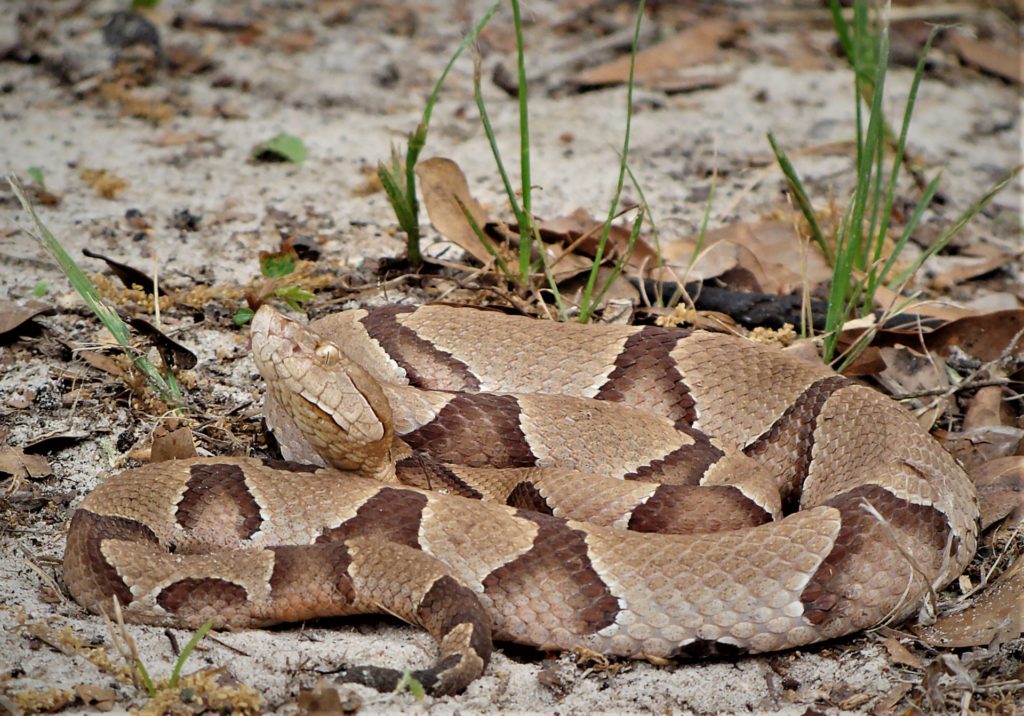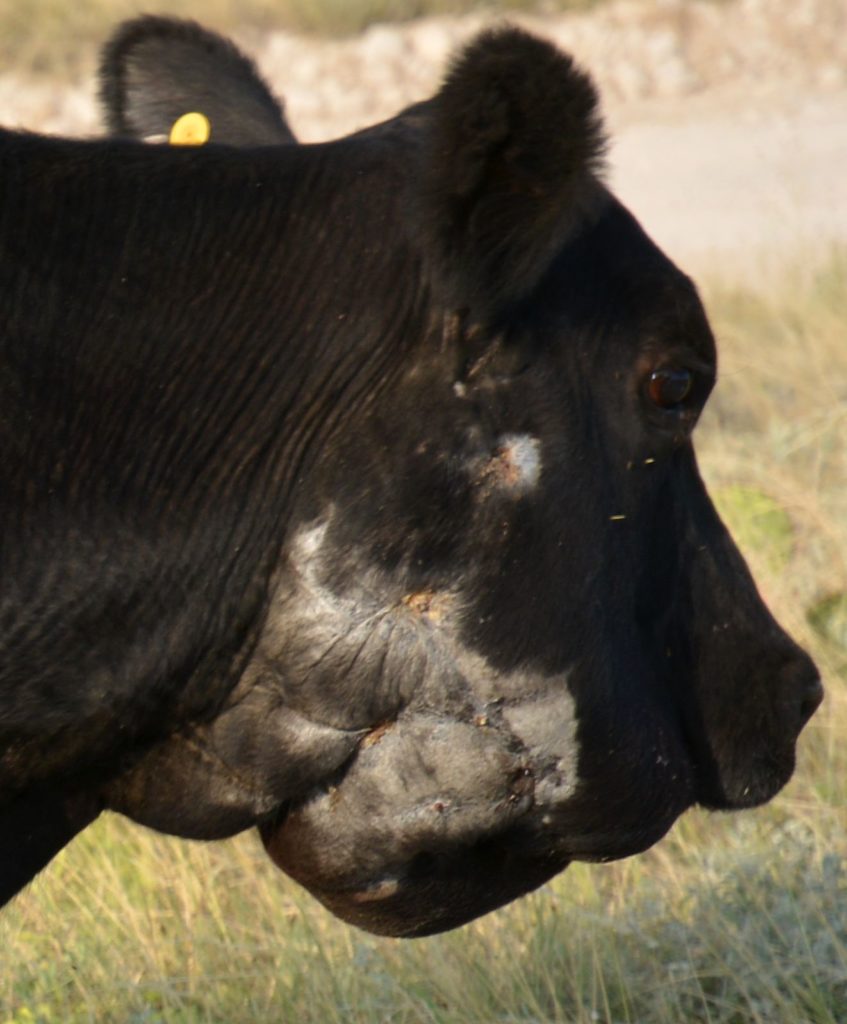Give them some room to avoid bites
It’s summertime, and like it or not, snakes are out.
Last year, several news organizations reported an increase in the number of venomous snake bites in Texas and other states like North Carolina and Georgia.
Rapid urbanization and higher-than-normal amounts of rain were blamed for the spike in bites, especially since they were occurring more frequently in suburban areas.

The copperhead is among four venomous snakes, including rattlesnakes, cottonmouths and coral snakes, that people should watch for while walking. Their pattern blends well with fallen leaves and debris on the ground. (Texas A&M AgriLife Extension photo by Maureen Frank)
Maureen Frank, Ph.D., Texas A&M AgriLife Extension Service wildlife specialist, Uvalde, said snakes, whether we like them or fear them, are active around the house and in their natural habitat this time of year.
People can encounter snakes while walking trails, camping or just doing summer yardwork around the house, she said. There’s little to fear about snakes if a few basic precautions and principles are applied before and during an encounter.
Snakes are integral to Texas’ array of regional ecosystems. While many Texans view them as a dangerous pest, they are an important predator of insects and animals.
There are around 75 snake species in the Lone Star State, but only about a dozen are venomous.
Even though most species are non-venomous, Frank said her best advice is to avoid contact with any snake. Snakes are typically not aggressive and will typically escape an area if they hear someone approaching.
Frank said the best ways to avoid snake bites is to watch where you step or reach and to keep your distance if you see one.
“When you encounter a snake, it’s best to just leave it alone,” she said. “Most bites occur when a person is trying to handle the snake or trying to kill it. It’s best to give them plenty of room and let them go on their way.”
Where and when you might encounter a snake
Because snakes are cold-blooded, they prefer sun and/or stretching out on warm surfaces like rocks, pavement and other heat-absorbing materials when temperatures are cooler. But in the heat of the summer, they prefer shade, especially from the midday sun.
“People need to take these environmental conditions into account,” she said. “On a cool morning, you may find a snake sunning a rock along a hiking trail or the stones in a walkway or a paved walking trail. When it’s hot they may be in the shade under a bush or sheet of plywood or in a brush pile. These are things to consider when you go outside.”
Frank said venomous snakes typically do not want to use their venom as a defense. They usually give warnings – like rattlesnakes rattling – before they strike. The Texas Department of Health Services reported that half the reported bites by venomous snakes were “dry,” meaning no venom was injected into the victim.
“A snake strikes because it views you as a threat,” she said. “Producing venom is an energetically costly process, and they only have so much. If they use it, they must make more to hunt for food, and they have to work for every single meal, so striking to defend themselves is something they would rather avoid.”
To avoid snake bites, Frank said people should consider their location and be cautiously aware of where they step or reach, such as picking up a log for firewood.
Reduce snake attractors around the house
There are no chemical repellants proven to deter snakes, Frank said, but there are two things homeowners can do to reduce the likelihood of snakes hanging around a location – remove potential shelter and food.
“It’s best to take the habitat approach and remove the things that attract snakes,” she said. “Cutting the grass, removing brush and debris, and trimming the lower branches on bushes and trees will go a long way in reducing the places a snake might want to hide.”
Frank said AgriLife Extension researchers are conducting experiments in the Hill Country to see what type of cover they prefer by placing various items like lumber including sheets of plywood, sheet metal and other things that could act as potential hiding spots snakes might utilize.
Reducing hiding spots for snakes will also reduce hiding spots for the prey they seek, like rats and mice, she said. Cleaning around the house and other structures to remove trash, which is shelter for small prey animals, also helps keep snakes away.
Be careful when moving debris and other items that snakes might use for cover, Frank said. Use tools like a shovel or the tip of a boot.
Teach children not to reach inside crevices and under bushes with low-hanging limbs, she said.
“They need to know they shouldn’t reach into a place if they can’t see what might be in there,” she said.
Frank said homeowners should also take precautions to reduce the chance of their pet encountering a snake, such as having them on a leash during walks.
Snakes of Texas

A milk snake’s black, white and red pattern mimics the black, yellow and red pattern of the venomous coral snake. Even non-venomous snakes will bite if they feel threatened, so it’s best to avoid them. (Texas A&M AgriLife Extension photo by Maureen Frank)
Common non-venomous species found throughout Texas include garter snakes, which people also refer to as garden snakes; rat snakes, also known as chicken snakes; and bull snakes. Common venomous snakes include western diamond-backed rattlesnakes, copperheads and the cottonmouth, also known as the water moccasin.
The range of species and likelihood of an encounter differ from region to region and specific locations. For instance, it’s much more likely to see a cottonmouth around bodies of water, like ponds, lakes or creeks, as well as bottomlands that maintain high levels of moisture throughout the seasons.
“Being able to identify a snake can help you avoid danger,” she said. “But the best advice is to keep your distance and avoid contact.”
Snake bites
Most snake bites to humans occur to the feet/lower leg or the hands, Frank said.
Despite common misconceptions on how to deal with a venomous snake bite, she said it’s best to stay calm and get to a hospital as quickly as possible.
First, try to identify the snake species, Frank said. This is especially important for coral snakes because the treatments differ significantly from those to treat copperhead, cottonmouth or rattlesnake bites.
“Do not try to kill it,” she said. “The emergency room doctors don’t need it. They just need a decent description of the snake or take a photo of it with your cell phone if it’s safe to do so. If someone else tries to get the snake, you run the risk that the doctor may be dealing with two snake bite victims.”
Frank said the victim should remove clothing like socks if bitten on the foot and items like rings on fingers if bitten on the hand because of swelling.
Tourniquets and suction devices or using other mythologized methods to remove snake venom could do more harm than good, she said. Hospitals have anti-venom on hand to deal with bites.
“Just focus on getting to the hospital quickly but safely,” she said.
Bites to pets
Christine Rutter, DVM, clinical assistant professor at the Veterinary Medical Teaching Hospital at Texas A&M University and emergency/critical care specialist, College Station, said snake bites to pets are very common, but the majority of cases are not lethal when the owner seeks immediate care.
Bite cases typically begin rising in March, Rutter said. Bites to dogs typically occur on or around the head, while cats are typically bitten in the front paws. Identifying the snake will help veterinarians with treatments, but agitated snakes can be very dangerous, and owners should not attempt to handle or kill them.
Even dead snakes can bite and should be left alone. If possible, a photograph of the snake is sufficient, but not required for emergency veterinary care.
Signs of a snake bite can include localized pain, bruising and swelling, or one or two small wounds trickling blood, she said.
“Not all snake bites are life threatening. Some may only require pain management and cleaning the wound, but others can be nasty and cause paralysis, tissue damage and potentially death,” she said. “It’s my recommendation to take your pet to a vet sooner rather than later if there is a suspicion that your animal was bitten by a venomous snake. Outcomes are typically more survivable with early treatment.”
Rutter said it is nearly impossible to totally prevent snake/pet encounters outside the home. But turning on lights at night, checking the backyard area and/or making noise to announce your presence and giving snakes 20-30 seconds to leave are good starting points.
Keeping control of your dog on or off leash can also help, she said.
“If your pet is interested in something in the shrubbery, that’s typically not good, so you should probably stop the interaction,” she said. “Whether it’s an armadillo or a snake, that’s an encounter I don’t recommend.”
Rutter said snake bites are one reason she recommends pet insurance for emergencies.
“Emergency and critical care can be expensive,” she said. “Throw in the cost of anti-venom and that can turn a pleasant afternoon into a bad day.”
Bites to large animals

Venomous snakes can be a hazard for livestock but are typically not lethal for large animals. (Texas A&M AgriLife Communications photo by Steve Byrns)
Dusty Nagy, Ph.D., clinical associate professor in large animal clinical sciences at the Veterinary Medical Teaching Hospital at Texas A&M, said she rarely sees snake bites in large ruminant animals including cattle, sheep and goats. However, when a large animal is bitten, a bite to the face is the most common.
Nagy said she is not aware of a lethal snake bite to larger animals likely due to their size. But she said snake bites can cause cellulitis and secondary infections that can impede an animal’s ability to eat.
Most of the time the bites are not noticed by ranchers unless there is severe swelling due to a secondary infection, she said.
“Typically, when they get to us our focus is pain management,” Nagy said. “In bad cases where there is an abscess or extreme swelling that is affecting their ability to eat, we will drain it or clean the wound and possibly give the animal anti-inflammatories and antibiotics.”
-30-
The post “Snakes are out” first appeared on AgriLife Today.